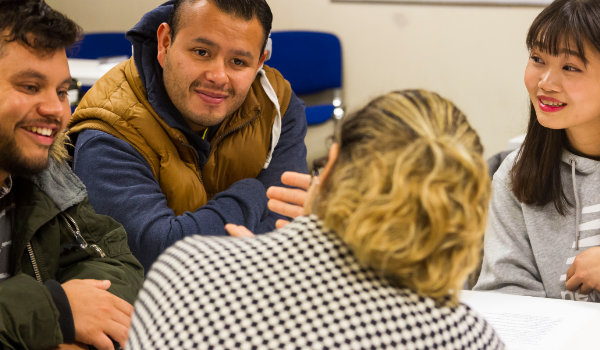By Jennifer Tong*
Even though we just heard that we are entering a ‘sixth wave’ of the pandemic, the Ontario government has stuck to its policies of lifting public health restrictions and re-opening the economy. We may be leaving the acute or emergency phase of the pandemic. Many ESL classes, which have changed to an online format over the past two years, are starting to change back into in-person format. This transition into a ‘post-pandemic’ mode is in the minds of a lot of ESL coordinators and teachers currently. I would like to look at some general considerations regarding this shift, as well as some specifics of what changing back to in-person classes might entail.
In thinking about whether and how to transition back to in-person classes, an important first consideration may be the needs and preferences of students and teachers who are already in the online classes. Many coordinators of ESL programs have found that there is a variety of needs and preferences. For students who have joined the program online during the pandemic, they may be living far from the church where the program meets in-person; they may even be from another province or another country. For them, classes have to stay online. Other students prefer the convenience of online classes because they live busy lives or are worried about transportation and travel, especially in the winter. Elderly students may prefer online for safety reasons, though some are technologically challenged. On the other hand, some students are eager to resume in-person classes. Some have found that this is especially the case with beginning students and those who are newer to Canada. They need and desire the opportunity to socialize and the in-person contact. For teachers, it is likely that some prefer online and some prefer in-person. Perhaps the best way is to allow the teachers to choose, if both kinds of classes are provided.
Because of the mix of perspectives and needs, many programs choose to think about and adopt a ‘hybrid’ mode, where both online and in-person classes are offered. This can mean various things. For example, we can alternate between an online class and an in-person class in different weeks. Each class can accommodate different students. We can also have different times of meetings within a week, with both in-person and online classes. These classes can be of different levels, with each class deciding the mode they want to go forward in. A ‘hybrid’ mode can also mean having an online class and an in-person class in the same time slot, with students choosing which they want to participate in from week to week, though this might pose some organizational challenges. It seems that one of the considerations for this hybrid mode is the availability and schedules of the teachers. We may or may not have enough volunteers for the number of classes because for some classes, both in-person and online formats are offered.
Another consideration for transitioning back to in-person classes, especially if some sort of a mixed mode is offered, is that it may need to be based on trial and error. Some programs have run a ‘trial’ of in-person classes just to see how it goes before committing to them. Others have gone back and forth, with in-person classes opening and closing down again, both because of government restrictions and student preference. This was especially the case in the past when waves of the pandemic were still coming and going. Whether this will still be the case in the future or not, it will be good to be flexible and willing to try out different things.
As for the specifics of in-person classes after the pandemic, here are some things we need to consider:
(i) How is the ventilation of the room? We can request a well-ventilated room and open the windows slightly if possible.
(ii) How is the room to be set up? Do we still need to distance? It may not be a requirement any more but what are the preferences of most? If distanced, do students have to ‘shout’ at each other or will there be echoes? Do we sit around tables? The way we lean forward at tables may mean physical distance is reduced. If not around tables, we could think of providing lap desks (especially those with whiteboards on top) for students to write on while they sit in circles.
(iii) What would be the protocols for masks? Can we hear each other clearly with masks on? Are there ‘alternative’ masks where the mouths of students and teachers can be seen? We hear of clear masks that are used by the school boards, or masks with a clear window for the mouth. (Search “clear mask” on Amazon or Showcase.) We may have to follow the church’s policy on masks.
(iv) Would there be vaccination requirements? We probably have to consult the church under which the program is offered. We also have to think of whether this would be ‘discriminatory’, though such requirements may increase safety.
(v) How do we handle snacks, or should we still have them? We may want to be especially careful about handling food and sharing it. Limiting to individually wrapped snacks might be an option, and it may be good to provide hand sanitizer. As well, a dedicated server of snacks may ensure a no-touch solution.
There may be other specifics that you can think of.
Some other miscellaneous considerations: For larger programs, we may consider having an online system of registration and assessment in place, even when in-person classes have started, while still having in-person registration and assessment options for the walk-ins and those who are not familiar with technology. We may need to think of specific student populations like the elderly who are at higher risks for the virus, or students from certain countries who may have taken different vaccines. We may have to prepare for lower numbers for the in-person classes as some might choose online; and of the students who return from classes pre-Covid, they may have changed physically and mentally due to the ordeal of these two years. Also, the online option is a bit more ‘divorced’ from the church community and its witness.
All this is not to say that online classes are not good or viable. Even after the pandemic, some churches may still choose to offer online classes only. The many benefits of online classes have been explored in other articles in this publication (see, for example, Interview with Andrew Urbanowicz, a 94-year-old ESL teacher – Part 2 and An Online ESL Program Success Story). We can also choose to have outings with the students from time to time even when we are purely online. The bottom line: evaluate your particular circumstances and settings and come up with the best decision forward.
* Special thanks to Roslyn Farmer, Mary Ellen Tierney and Simon Yung for their input for this article.


One reply on “Transitioning to “Post-Pandemic” ESL”
This is well written and gave much food for thought.